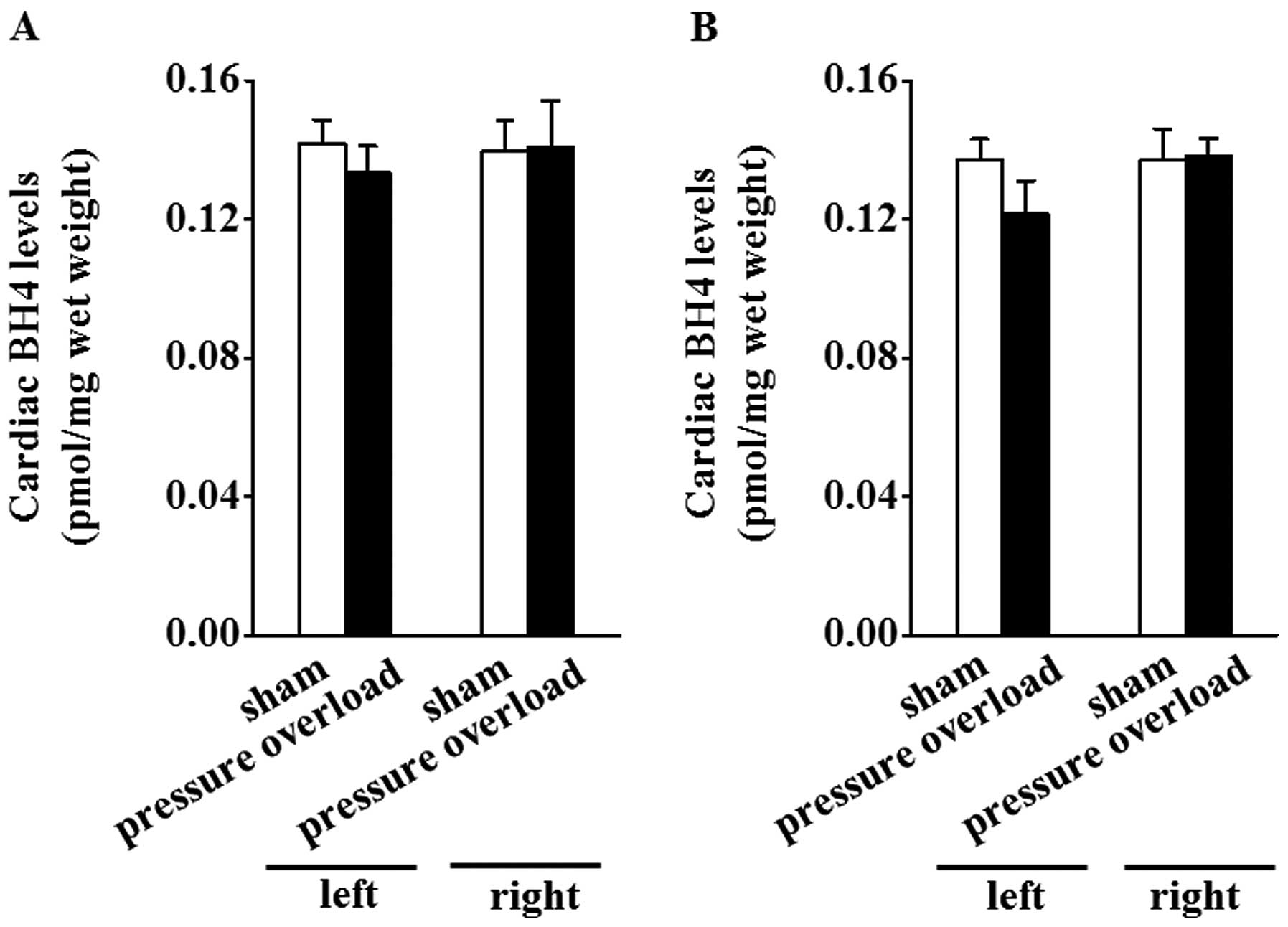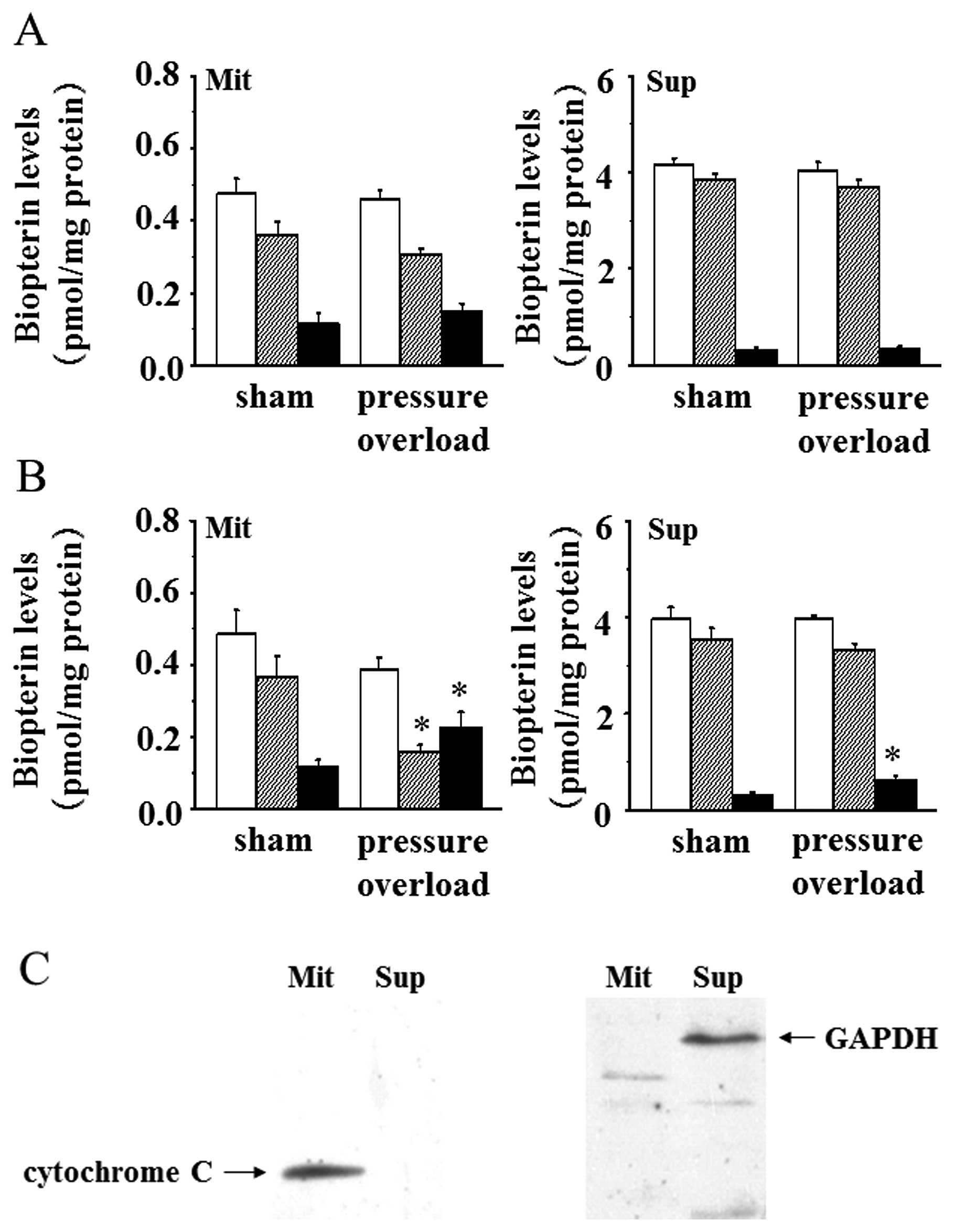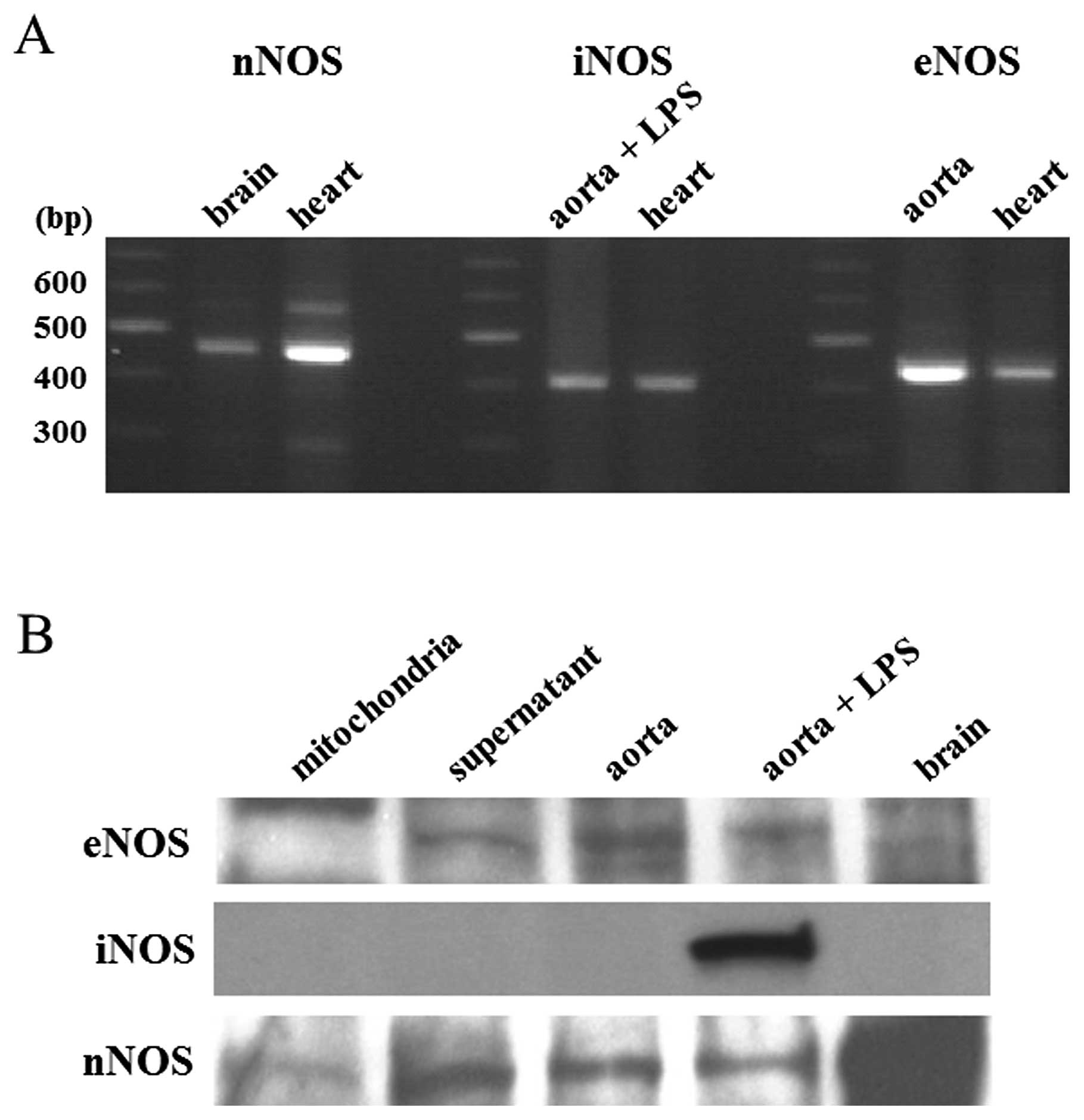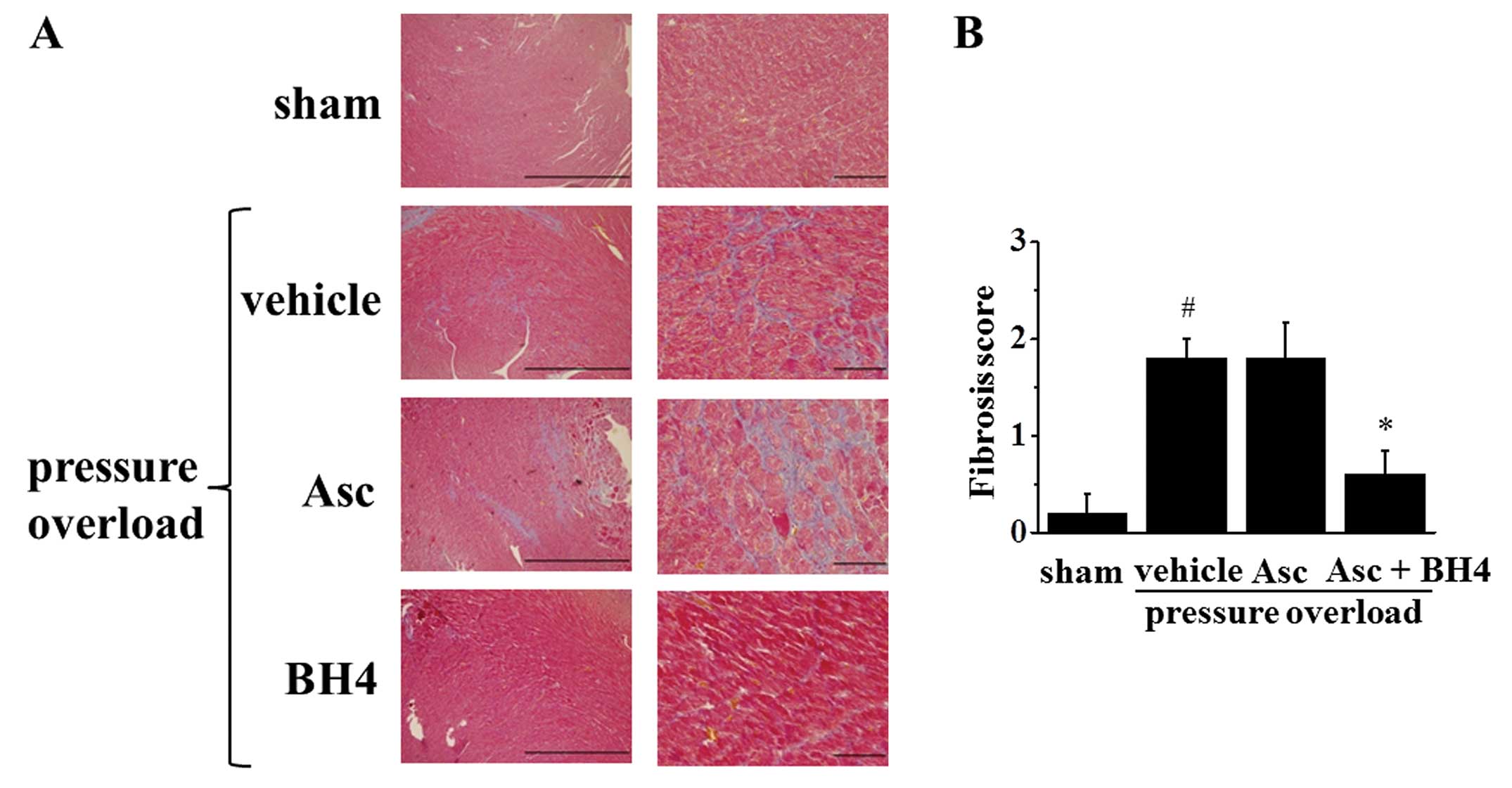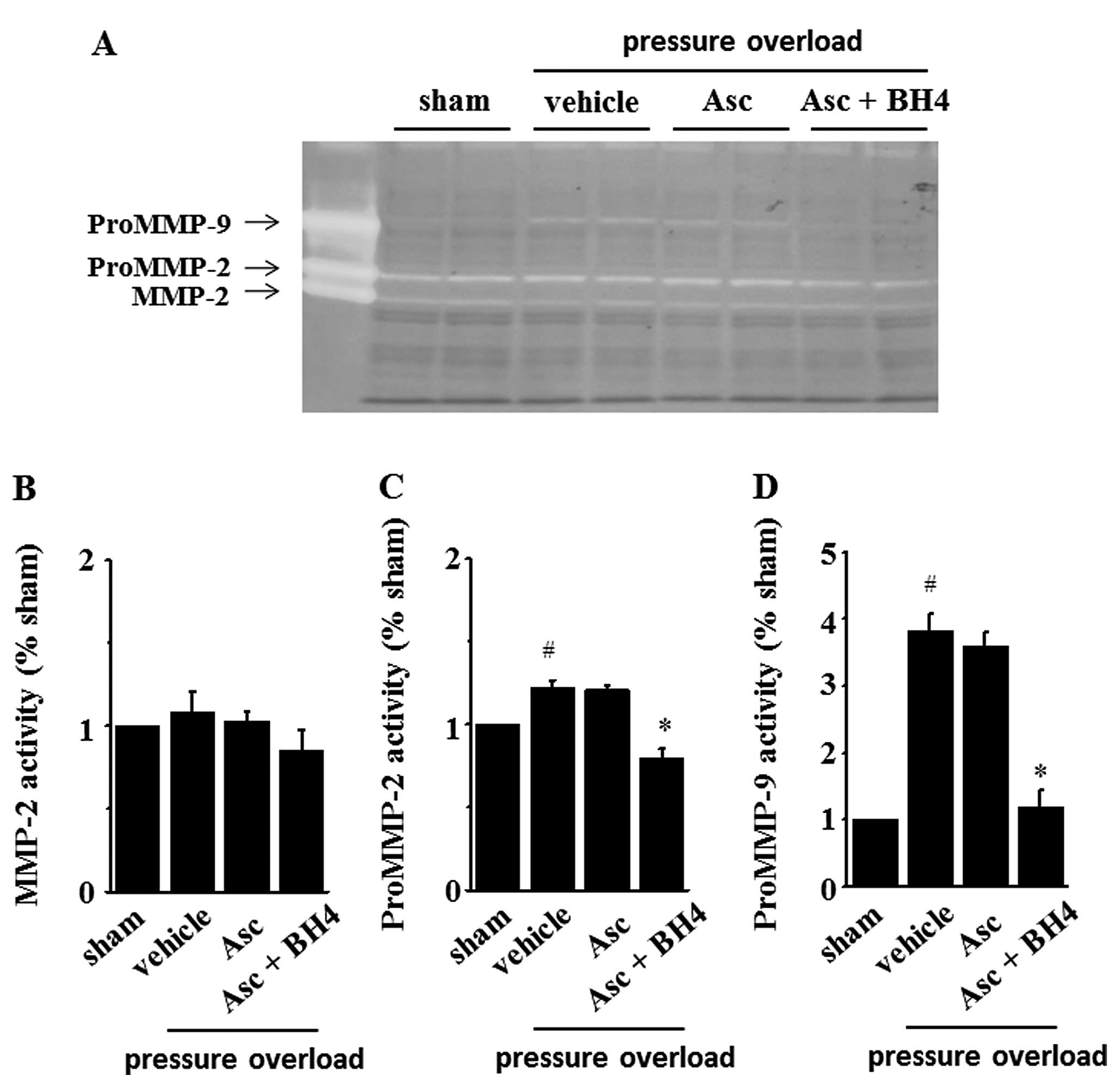|
1
|
MacCarthy PA, Grieve DJ, Li JM, Dunster C,
Kelly FJ and Shah AM: Impaired endothelial regulation of
ventricular relaxation in cardiac hypertrophy: role of reactive
oxygen species and NADPH oxidase. Circulation. 104:2967–2974. 2001.
View Article : Google Scholar : PubMed/NCBI
|
|
2
|
Takimoto E and Kass DA: Role of oxidative
stress in cardiac hypertrophy and remodeling. Hypertension.
49:241–248. 2007. View Article : Google Scholar : PubMed/NCBI
|
|
3
|
Kwon NS, Nathan CF and Stuehr DJ: Reduced
biopterin as a cofactor in the generation of nitrogen oxides by
murine macrophages. J Biol Chem. 264:20496–20501. 1989.PubMed/NCBI
|
|
4
|
Tayeh MA and Marletta MA: Macrophage
oxidation of L-arginine to nitric oxide, nitrite, and nitrate.
Tetrahydrobiopterin is required as a cofactor. J Biol Chem.
264:19654–19658. 1989.PubMed/NCBI
|
|
5
|
Werner-Felmayer G, Werner ER, Fuchs D,
Hausen A, Reibnegger G and Wachter H: Tetrahydrobiopterin-dependent
formation of nitrite and nitrate in murine fibroblasts. J Exp Med.
172:1599–1607. 1990. View Article : Google Scholar : PubMed/NCBI
|
|
6
|
Schmidt K, Werner ER, Mayer B, Wachter H
and Kukovetz WR: Tetrahydrobiopterin-dependent formation of
endothelium-derived relaxing factor (nitric oxide) in aortic
endothelial cells. Biochem J. 281:297–300. 1992.
|
|
7
|
Werner ER, Gorren ACF, Heller R,
Werner-Felmayer G and Mayer B: Tetrahydrobiopterin and nitric
oxide: mechanistic and pharmacological aspects. Exp Biol Med.
228:1291–1302. 2003.PubMed/NCBI
|
|
8
|
Wever RM, van Dam T, van Rijn HJ, de Groot
F and Rabelink TJ: Tetrahydrobiopterin regulates superoxide and
nitric oxide generation by recombinant endothelial nitric oxide
synthase. Biochem Biophys Res Commun. 237:340–344. 1997. View Article : Google Scholar : PubMed/NCBI
|
|
9
|
Vásquez-Vivar J, Kalyanaraman B, Martásek
P, Hogg N, Masters BS, Karoui H, Tordo P and Pritchard KA Jr:
Superoxide generation by endothelial nitric oxide synthase: the
influence of cofactors. Proc Natl Acad Sci USA. 95:9220–9225.
1998.PubMed/NCBI
|
|
10
|
Xia Y, Tsai AL, Berka V and Zweier JL:
Superoxide generation from endothelial nitric-oxide synthase. A
Ca2+/calmodulin-dependent and tetrahydrobiopterin
regulatory process. J Biol Chem. 273:25804–25808. 1998. View Article : Google Scholar : PubMed/NCBI
|
|
11
|
Malo O, Desjardins F, Tanguay J, Tardif J,
Carrier M and Perrault LP: Tetrahydrobiopterin and antioxidants
reverse the coronary endothelial dysfunction associated with left
ventricular hypertrophy in a porcine model. Cardiovasc Res.
59:501–511. 2003. View Article : Google Scholar : PubMed/NCBI
|
|
12
|
Moens AL, Takimoto E, Tocchetti CG, Chakir
K, Bedja D, Cormaci G, Ketner EA, Majmudar M, Gabrielson K,
Halushka MK, Mitchell JB, Biswal S, Channon KM, Wolin MS, Alp NJ,
Paolocci N, Champion HC and Kass DA: Reversal of cardiac
hypertrophy and fibrosis from pressure overload by
tetrahydrobiopterin: efficacy of recoupling nitric oxide synthase
as a therapeutic strategy. Circulation. 117:2626–2636. 2008.
View Article : Google Scholar : PubMed/NCBI
|
|
13
|
Silberman GA, Fan THM, Liu H, Jiao Z, Xiao
HD, Lovelock JD, Boulden BM, Widder J, Fredd S, Bernstein KE,
Wolska BM, Dikalov S, Harrison DG and Dudley SC Jr: Uncoupled
cardiac nitric oxide synthase mediates diastolic dysfunction.
Circulation. 121:519–528. 2010. View Article : Google Scholar : PubMed/NCBI
|
|
14
|
Moens AL, Ketner EA, Takimoto E, Schmidt
TS, O’Neill CA, Wolin MS, Alp NJ, Channon KM and Kass DA: Bi-modal
dose-dependent cardiac response to tetrahydrobiopterin in
pressure-overload induced hypertrophy and heart failure. J Mol Cell
Cardiol. 51:564–569. 2011. View Article : Google Scholar : PubMed/NCBI
|
|
15
|
Takimoto E, Champion HC, Li M, Ren S,
Rodriguez ER, Tavazzi B, Lazzarino G, Paolocci N, Gabrielson KL,
Wang Y and Kass DA: Oxidant stress from nitric oxide synthase-3
uncoupling stimulates cardiac pathologic remodeling from chronic
pressure load. J Clin Invest. 115:1221–1231. 2005. View Article : Google Scholar : PubMed/NCBI
|
|
16
|
Brookes PS: Mitochondrial nitric oxide
synthase. Mitochondrion. 3:187–204. 2004. View Article : Google Scholar
|
|
17
|
Haynes V, Elfering S, Traaseth N and
Giulivi C: Mitochondrial nitric-oxide synthase: enzyme expression,
characterization, and regulation. J Bioenerg Biomembr. 36:341–346.
2004. View Article : Google Scholar : PubMed/NCBI
|
|
18
|
Finocchietto PV, Franco MC, Holod S,
Gonzalez AS, Converso DP, Arciuch VGA, Serra MP, Poderoso JJ and
Carreras MC: Mitochondrial nitric oxide synthase: a masterpiece of
metabolic adaptation, cell growth, transformation, and death. Exp
Biol Med. 234:1020–1028. 2009. View Article : Google Scholar : PubMed/NCBI
|
|
19
|
Kanai AJ, Pearce LL, Clemens PR, Birder
LA, VanBibber MM, Choi SY, de Groat WC and Peterson J:
Identification of a neuronal nitric oxide synthase in isolated
cardiac mitochondria using electrochemical detection. Proc Natl
Acad Sci USA. 98:14126–14131. 2001. View Article : Google Scholar : PubMed/NCBI
|
|
20
|
Brown GC and Borutaite V: Nitric oxide and
mitochondrial respiration in the heart. Cardiovasc Res. 75:283–290.
2007. View Article : Google Scholar : PubMed/NCBI
|
|
21
|
Carreras MC, Franco MC, Finocchietto PV,
Converso DP, Antico Arciuch VG, Holod S, Peralta JG and Poderoso
JJ: The biological significance of mtNOS modulation. Front Biosci.
12:1041–1048. 2007. View
Article : Google Scholar : PubMed/NCBI
|
|
22
|
Dedkova EN and Blatter LA: Characteristics
and function of cardiac mitochondria nitric oxide synthase. J
Physiol. 587:851–872. 2009. View Article : Google Scholar : PubMed/NCBI
|
|
23
|
Faerber G, Barreto-Perreia F, Schoepe M,
Gilsbach R, Schrepper A, Schwarzer M, Mohr FW, Hein L and Doenst T:
Induction of heart failure by minimally invasive aortic
constriction in mice: reduced peroxisome proliferator-activated
receptor γ coactivator levels and mitochondrial dysfunction. J
Thorac Cardiovasc Surg. 141:492–500. 2011.PubMed/NCBI
|
|
24
|
Givvimani S, Munjal C, Tyagi N, Sen U,
Metreveli N and Tyagi SC: Mitochondrial division/mitophagy
inhibitor (Mdivi) ameliorates pressure overload induced heart
failure. PLoS One. 7:e323882012. View Article : Google Scholar : PubMed/NCBI
|
|
25
|
Dai DF, Hsieh EJ, Liu Y, Chen T, Beyer RP,
Chin MT, MacCoss MJ and Rabinovitch PS: Mitochondrial proteome
remodelling in pressure overload-induced heart failure: the role of
mitochondrial oxidative stress. Cardiovasc Res. 93:79–88. 2012.
View Article : Google Scholar : PubMed/NCBI
|
|
26
|
Bugger H, Schwarzer M, Chen D, Schrepper
A, Amorim PA, Schoepe M, Nguyen TD, Mohr FW, Khalimonchuk O, Weimer
BC and Doenst T: Proteomic remodelling of mitochondrial oxidative
pathways in pressure overload-induced heart failure. Cardiovasc
Res. 85:376–384. 2010. View Article : Google Scholar : PubMed/NCBI
|
|
27
|
Yorikane R, Sakai S, Miyauchi T, Sakurai
T, Sugishita Y and Goto K: Increased production of endothelin-1 in
the hypertrophied rat heart due to pressure overload. FEBS Lett.
332:31–34. 1993. View Article : Google Scholar : PubMed/NCBI
|
|
28
|
Heller R, Unbehaun A, Schellenberg B,
Mayer B, Werner-Felmayer G and Werner ER: L-ascorbic acid
potentiates endothelial nitric oxide synthesis via a chemical
stabilization of tetrahydrobiopterin. J Biol Chem. 276:40–47. 2001.
View Article : Google Scholar : PubMed/NCBI
|
|
29
|
Valent S and Tóth M: Spectrophotomeric
analysis of the protective effect of ascorbate against spontaneous
oxidation of tetrahydrobiopterin in aqueous solution: kinetic
characteristics and potentiation by catalase of ascorbate action.
Int J Biochem Cell Biol. 36:1266–1280. 2004. View Article : Google Scholar
|
|
30
|
Tóth M, Kukor Z and Valent S: Chemical
stabilization of tetrahydrobiopterin by L-ascorbic acid:
contribution to placental endothelial nitric oxide synthase
activity. Mol Hum Reprod. 8:271–280. 2002.PubMed/NCBI
|
|
31
|
Fellet AL, Balaszczuk AM, Arranz C,
López-Costa JJ, Boveris A and Bustamante J: Autonomic regulation of
pacemaker activity: role of heart nitric oxide synthases. Am J
Physiol Heart Circ Physiol. 291:H1246–H1254. 2006. View Article : Google Scholar : PubMed/NCBI
|
|
32
|
Wajima T, Shimizu S, Hiroi T, Ishii M and
Kiuchi Y: Reduction of myocardial infarct size by
tetrahydrobiopterin: possible involvement of mitochondrial
KATP channels activation through nitric oxide
production. J Cardiovasc Pharmacol. 47:243–249. 2006. View Article : Google Scholar : PubMed/NCBI
|
|
33
|
Hiroi T, Wajima T, Kaneko Y, Kiuchi Y and
Shimizu S: An important role of increase in tetrahydrobiopterin via
H2O2-JAK2 signalling pathway in late phase of
ischaemic preconditioning. Exp Physiol. 95:609–621. 2010.PubMed/NCBI
|
|
34
|
Shimizu S, Shiota K, Yamamoto S, Miyasaka
Y, Ishii M, Watabe T, Nishida M, Mori Y, Yamamoto T and Kiuchi Y:
Hydrogen peroxide stimulates tetrahydrobiopterin synthesis through
the induction of GTP-cyclohydrolase I and increases nitric oxide
synthase activity in vascular endothelial cells. Free Radic Biol
Med. 34:1343–1352. 2003. View Article : Google Scholar
|
|
35
|
Zaobornyj T, Valdez LB, La Padula P, Costa
LE and Boveris A: Effect of sustained hypobaric hypoxia during
maturation and aging on rat myocardium. II mitNOS activity. J Appl
Physiol. 98:2370–2375. 2005. View Article : Google Scholar : PubMed/NCBI
|
|
36
|
Giulivi C, Kato K and Cooper CE: Nitric
oxide regulation of mitochondrial oxygen consumption I: cellular
physiology. Am J Physiol Cell Physiol. 291:C1225–C1231. 2006.
View Article : Google Scholar : PubMed/NCBI
|
|
37
|
Baines CP: The cardiac mitochondrion:
nexus of stress. Annu Rev Physiol. 72:61–80. 2010. View Article : Google Scholar : PubMed/NCBI
|
|
38
|
Konstantinidis K, Whelan RS and Kitsis RN:
Mechanisms of cell death in heart disease. Arterioscler Thromb Vasc
Biol. 32:1552–1562. 2012. View Article : Google Scholar : PubMed/NCBI
|
|
39
|
García-Cardeña G, Oh P, Liu J, Schnitzer
JE and Sessa WC: Targeting of nitric oxide synthase to endothelial
cell caveolae via palmitoylation: implications for nitric oxide
signaling. Proc Natl Acad Sci USA. 93:6448–6453. 1996.PubMed/NCBI
|
|
40
|
Feron O and Balligand JL: Caveolins and
the regulation of endothelial nitric oxide synthase in the heart.
Cardiovasc Res. 69:788–797. 2006. View Article : Google Scholar : PubMed/NCBI
|















